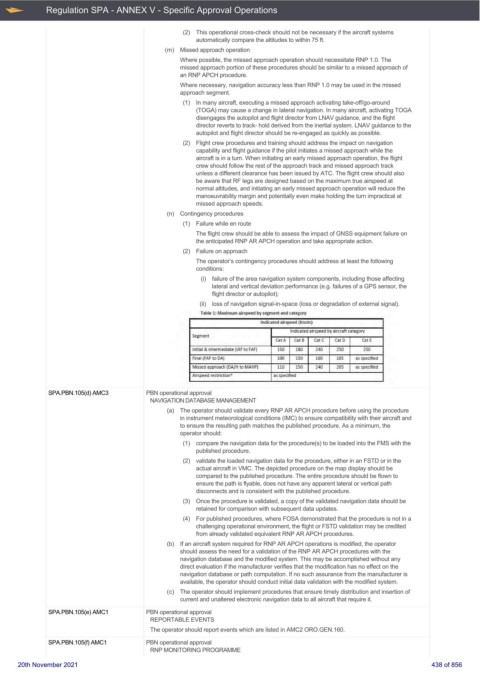Page 438 - UK Air Operations Regulations 201121
P. 438
~ Regulation SPA - ANNEX V - Specific Approval Operations n trik
(2) This operational cross-check should not be necessary if the aircraft systems
automatically compare the altitudes to within 75 ft.
(m) Missed approach operation
Where possible, the missed approach operation should necessitate RNP 1.0. The
missed approach portion of these procedures should be similar to a missed approach of
an RNP APCH procedure.
Where necessary, navigation accuracy less than RNP 1.0 may be used in the missed
approach segment.
(1) In many aircraft, executing a missed approach activating take-off/go-around
(TOGA) may cause a change in lateral navigation. In many aircraft, activating TOGA
disengages the autopilot and flight director from LNAV guidance, and the flight
director reverts to track- hold derived from the inertial system. LNAV guidance to the
autopilot and flight director should be re-engaged as quickly as possible.
(2) Flight crew procedures and training should address the impact on navigation
capability and flight guidance if the pilot initiates a missed approach while the
aircraft is in a turn. When initiating an early missed approach operation, the flight
crew should follow the rest of the approach track and missed approach track
unless a different clearance has been issued by ATC. The flight crew should also
be aware that RF legs are designed based on the maximum true airspeed at
normal altitudes, and initiating an early missed approach operation will reduce the
manoeuvrability margin and potentially even make holding the turn impractical at
missed approach speeds.
(n) Contingency procedures
(1) Failure while en route
The flight crew should be able to assess the impact of GNSS equipment failure on
the anticipated RNP AR APCH operation and take appropriate action.
(2) Failure on approach
The operator’s contingency procedures should address at least the following
conditions:
(i) failure of the area navigation system components, including those affecting
lateral and vertical deviation performance (e.g. failures of a GPS sensor, the
flight director or autopilot);
(ii) loss of navigation signal-in-space (loss or degradation of external signal).
Table 1: Maximum airspeed by segment Bild category
Indicat ed airspeed jKnots)
Indicated airspeed by aircraft category
Segment
cat A cat B cat C cat D catE
Initial & in·termediate (IAF to FAF) 150 180 240 250 250
Final IF AF to DA) 100 130 160 185 as specified
Missed approach I DA/H to MAHP) 110 150 240 265 as specified
Airspeed restriction· as specified
SPA.PBN.105(d) AMC3 PBN operational approval
NAVIGATION DATABASE MANAGEMENT
(a) The operator should validate every RNP AR APCH procedure before using the procedure
in instrument meteorological conditions (IMC) to ensure compatibility with their aircraft and
to ensure the resulting path matches the published procedure. As a minimum, the
operator should:
(1) compare the navigation data for the procedure(s) to be loaded into the FMS with the
published procedure.
(2) validate the loaded navigation data for the procedure, either in an FSTD or in the
actual aircraft in VMC. The depicted procedure on the map display should be
compared to the published procedure. The entire procedure should be flown to
ensure the path is flyable, does not have any apparent lateral or vertical path
disconnects and is consistent with the published procedure.
(3) Once the procedure is validated, a copy of the validated navigation data should be
retained for comparison with subsequent data updates.
(4) For published procedures, where FOSA demonstrated that the procedure is not in a
challenging operational environment, the flight or FSTD validation may be credited
from already validated equivalent RNP AR APCH procedures.
(b) If an aircraft system required for RNP AR APCH operations is modified, the operator
should assess the need for a validation of the RNP AR APCH procedures with the
navigation database and the modified system. This may be accomplished without any
direct evaluation if the manufacturer verifies that the modification has no effect on the
navigation database or path computation. If no such assurance from the manufacturer is
available, the operator should conduct initial data validation with the modified system.
(c) The operator should implement procedures that ensure timely distribution and insertion of
current and unaltered electronic navigation data to all aircraft that require it.
SPA.PBN.105(e) AMC1 PBN operational approval
REPORTABLE EVENTS
The operator should report events which are listed in AMC2 ORO.GEN.160.
SPA.PBN.105(f) AMC1 PBN operational approval
RNP MONITORING PROGRAMME
20th November 2021 438 of 856

